
Nelson River Bipole
Encyclopedia
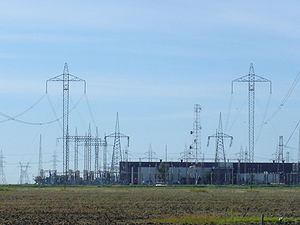
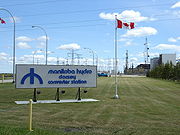
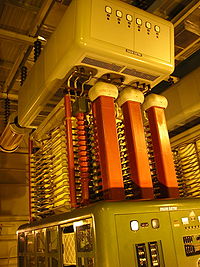
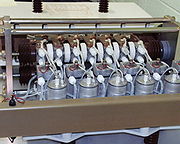
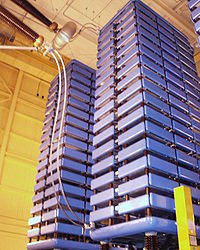
Electric power transmission
Electric-power transmission is the bulk transfer of electrical energy, from generating power plants to Electrical substations located near demand centers...
system of two high voltage, direct current lines in Manitoba
Manitoba
Manitoba is a Canadian prairie province with an area of . The province has over 110,000 lakes and has a largely continental climate because of its flat topography. Agriculture, mostly concentrated in the fertile southern and western parts of the province, is vital to the province's economy; other...
, operated by Manitoba Hydro
Manitoba Hydro
Manitoba Hydro is the electric power and natural gas utility in the province of Manitoba, Canada. Founded in 1961, it is a provincial Crown Corporation, governed by the Manitoba Hydro-Electric Board and the Manitoba Hydro Act. Today the company operates 15 interconnected generating stations. It has...
as part of the Nelson River Hydroelectric Project
Nelson River Hydroelectric Project
The Nelson River Hydroelectric Project refers to the construction of a series of dams and hydroelectric power plants on the Nelson River in Northern Manitoba, Canada...
. It is now recorded on the list of IEEE Milestones in electrical engineering
Electrical engineering
Electrical engineering is a field of engineering that generally deals with the study and application of electricity, electronics and electromagnetism. The field first became an identifiable occupation in the late nineteenth century after commercialization of the electric telegraph and electrical...
.
The system transfers electric power generated by several hydroelectric power stations along the Nelson River
Nelson River
The Nelson River is a river of north-central North America, in the Canadian province of Manitoba. Its full length is , it has mean discharge of , and has a drainage basin of , of which is in the United States...
in Northern Manitoba across the wilderness to the populated areas in the south. It includes two rectifier
Static inverter plant
A static inverter station, also known as an HVDC Converter Station, is the terminal equipment for a high-voltage direct-current transmission line, in which direct current is converted to three-phase alternating current, and, usually, the reverse...
stations, Radisson Converter Station near Gillam
Gillam, Manitoba
Gillam, Manitoba, Canada, is a community between Thompson and Churchill on the Hudson Bay Railway line. Gillam is a significant community because of the nearby Nelson River Bipole converter station on the Nelson River...
at 56°21′41"N 94°36′48"W and Henday Converter Station near Sundance
Sundance, Manitoba
Sundance was a community near the Nelson River in Northern Manitoba that was constructed in the mid-1980s to house the workers of the Limestone Dam project, who were employees of Manitoba Hydro, GE and other companies...
at 56°30′14"N 94°08′24"W, one inverter station
Static inverter plant
A static inverter station, also known as an HVDC Converter Station, is the terminal equipment for a high-voltage direct-current transmission line, in which direct current is converted to three-phase alternating current, and, usually, the reverse...
, Dorsey Converter Station at Rosser
Rosser, Manitoba
Rosser, Manitoba is a rural municipality lying adjacent to the northwest side of Winnipeg at . It is part of the Winnipeg Capital Region. Its population as of the 2001 census was 1,412....
(26 km from Winnipeg at49°59′34"N 97°25′42"W), and two sets of high-voltage direct current transmission lines, each with two parallel overhead conductors to carry the positive and negative feeds. There are no intermediate switching stations or taps. Both bipolar systems have extensive ground return electrodes to allow use in monopolar mode.
Bipole 1
Bipole 1 runs 895 km from Radisson to Dorsey. It is rated to run at a maximum potential difference of ±450 kilovolts and a maximum powerElectric power
Electric power is the rate at which electric energy is transferred by an electric circuit. The SI unit of power is the watt.-Circuits:Electric power, like mechanical power, is represented by the letter P in electrical equations...
of 1620 megawatts. This results in a electric current
Electric current
Electric current is a flow of electric charge through a medium.This charge is typically carried by moving electrons in a conductor such as wire...
of 1800 Ampere
Ampere
The ampere , often shortened to amp, is the SI unit of electric current and is one of the seven SI base units. It is named after André-Marie Ampère , French mathematician and physicist, considered the father of electrodynamics...
s. When it was built between March 1971 and October 1977, mercury arc valve
Mercury arc valve
A mercury-arc valve is a type of electrical rectifier used for converting high-voltage or high-current alternating current into direct current . Rectifiers of this type were used to provide power for industrial motors, electric railways, streetcars, and electric locomotives, as well as for...
s were used to rectify the alternating current
Alternating current
In alternating current the movement of electric charge periodically reverses direction. In direct current , the flow of electric charge is only in one direction....
. These were the most powerful mercury arc valves ever built. In 1993 the mercury arc valves of one pole were replaced with thyristor
Thyristor
A thyristor is a solid-state semiconductor device with four layers of alternating N and P-type material. They act as bistable switches, conducting when their gate receives a current trigger, and continue to conduct while they are forward biased .Some sources define silicon controlled rectifiers and...
s, increasing the maximum power and voltage of the line to its current levels. By the end of 2004 the last of the mercury arc valves had been replaced by thyristors.
Bipole 2
The Bipole 2 transmission line runs 937 km from Henday to Dorsey. Bipole 2 can transfer a maximum power of 1800 MW at a potential of ±500 kV. Bipole 2 was put into service in two stages. After the first stage in 1978 the maximum power was 900 MW at 250 kV, which increased to its present figure when it was completed in 1985. Unlike Radisson station, Henday station has always been equipped with thyristors.Bipole 3
In 1996 an extreme wind effect damaged both Bipole I and II and threatened to black out Winnipeg. Power was maintained by importing from MinnesotaMinnesota
Minnesota is a U.S. state located in the Midwestern United States. The twelfth largest state of the U.S., it is the twenty-first most populous, with 5.3 million residents. Minnesota was carved out of the eastern half of the Minnesota Territory and admitted to the Union as the thirty-second state...
while the two existing Bipoles were repaired. To avoid a repetition of this event, and further improve the reliability of the power supply, Manitoba Hydro is currently examining routes further to the west for their Bipole 3 line. The plans also include an additional converter station and feeder lines around the city. The in-service date for Bipole 3 is 2017.
Ground return electrodes
Although normally both lines run as bipolar systems, if a pole is shut down for maintenance or a fault, the ground return electrode is used to maintain partial capacity operation.Bipole 1 and 2 share a ring electrode 305 metres in diameter, 21.9 kilometres from the Dorsey Converter Plant at 50°10′29"N 97°24′08"W. At Radisson, Bipole 1 uses a ground electrode of same type, 11.2 kilometres away from the station at 56°21′22"N 94°45′17"W. Bipole 2 uses a ground electrode 548 metres in diameter, and 11.2 kilometres from the Henday Converter Plant 56°26′2"N 94°13′22"W. The Dorsey electrode is connected with the converter plant by two overhead lines on wooden poles, one for Bipole 1 and one for Bipole 2.
History
Construction in 1966 of the 1272 MW Kettle RapidsManitoba Hydro
Manitoba Hydro is the electric power and natural gas utility in the province of Manitoba, Canada. Founded in 1961, it is a provincial Crown Corporation, governed by the Manitoba Hydro-Electric Board and the Manitoba Hydro Act. Today the company operates 15 interconnected generating stations. It has...
generating station required a long transmission line to connect it to load centers in the southern part of Manitoba. The Government of Canada agreed to finance installation of an HVDC line to be repaid by Manitoba Hydro
Manitoba Hydro
Manitoba Hydro is the electric power and natural gas utility in the province of Manitoba, Canada. Founded in 1961, it is a provincial Crown Corporation, governed by the Manitoba Hydro-Electric Board and the Manitoba Hydro Act. Today the company operates 15 interconnected generating stations. It has...
when the load growth permitted the utility to assume the debt due to the line. Delivery of direct current electric power began on June 17, 1972.
One unit of the Kettle generating station was completed before the direct current converters were completed. For the winter of 1970 the bipole lines were energized with alternating current, contributing a useful amount of energy to the Manitoba system; a shunt reactor was installed to prevent excess voltage rise due to the Ferranti effect
Ferranti effect
The Ferranti effect is a rise in voltage occurring at the receiving end of a long transmission line, relative to the voltage at the sending end, which occurs when the line is energized but there is a very light load or the load is disconnected....
.
At that time, Bipole I used the world's highest operating voltage to deliver the largest amount of power from a remote site to a city, and employed the largest mercury arc valves ever developed for such an application. The line required construction of over 3,900 guyed towers and 96 self supporting towers across varied terrain. Permafrost in some areas led to foundation settling of up to 3 feet (1 m).
The loan by the Government of Canada was discharged when Manitoba Hydro bought the line and outstanding debt in 1992. In 1997 a tornado damaged 19 towers of the DC lines. During repairs, some major customers were advised to curtail load, but imports over the 500 kV lines from adjacent utilities in the United States prevented serious interruption of power.
A third such line, called Bipole 3 has been proposed, with current plans calling for it to run along the west side of Manitoba. On October 26, 2009, the Canadian Taxpayers Federation, along with engineering and environmental experts, released analysis which they claimed refuted each of the government's claims for why the line must be built down the west side of the province.
External links
- Manitoba Hydro
- http://web.archive.org/web/20051115122606/www.transmission.bpa.gov/cigresc14/Compendium/NELSON1.htm
- http://web.archive.org/web/20051115122606/www.transmission.bpa.gov/cigresc14/Compendium/NELSON2.htm
- http://web.archive.org/web/20051115122606/www.transmission.bpa.gov/cigresc14/Compendium/Nelson2%20Pictures.pdf

